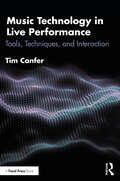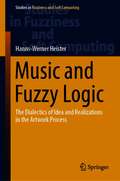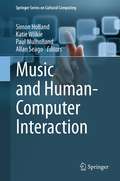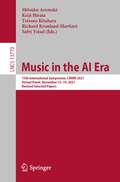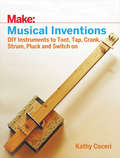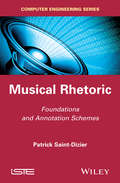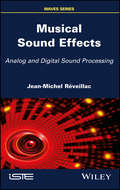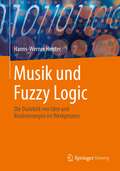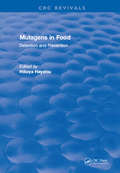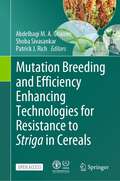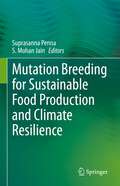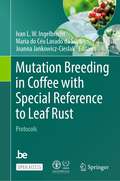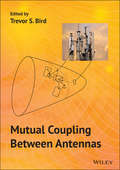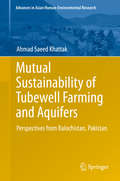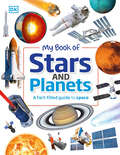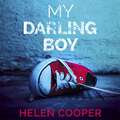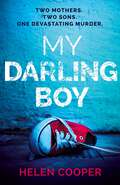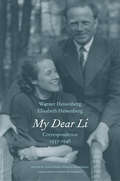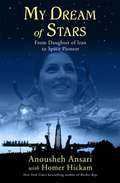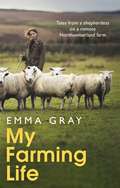- Table View
- List View
Music Technology in Live Performance: Tools, Techniques, and Interaction
by Tim CanferMusic Technology in Live Performance explores techniques to augment live musical performance and represents a comprehensive guide to best practices in music technology for live performance. This book presents a practical and accessible introduction to the theories of liveness and an array of live performance technologies and techniques. Areas covered include analogue and digital audio, live sound, the recording studio, and electronic music, revealing best professional practices and expert tips, alongside an exploration of approaches to increasing the exchange of energy in live performance. Music Technology in Live Performance is an ideal introduction for students of music performance, music production, and music technology, and a vital resource for professional musicians, producers, and technology developers.
Music and Fuzzy Logic: The Dialectics of Idea and Realizations in the Artwork Process (Studies in Fuzziness and Soft Computing #406)
by Hanns-Werner HeisterThis book unfolds the manifold, complex and intertwined relations between Fuzzy Logic and music in a first comprehensive overview on this topic: systematically as an outline, as completely as possible, in the aspects of Fuzzy Logic in this relation, and especially in music as a process with three main phases, five anthropological layers, and thirteen forms of existence of the art work (Classics, Jazz, Pop, Folklore). Being concerned with the ontological, gnoseological, psychological, and (music-) aesthetical status and the relative importance of different phenomena of relationship between music and Fuzzy Logic, the explication follows the four main principles (with five phenotypes) of Fuzzy Logic with respect to music: similarity, sharpening 1 as filtering, sharpening 2 as crystallization, blurring, and variation. The book reports on years of author’s research on topics that have been only little explored so far in the area of Music and Fuzzy Logic. It merges concepts of music analysis with fuzzy logical modes of thinking, in a unique way that is expected to attract both specialists of music and specialists of Fuzzy Logic, and also non-specialists in both fields. The book introduces the concept of dialectic between sharpening and – conscious – “blurring”. In turn, some important aspects of this dialectic are discussed, placing them in an historical dimension, and ending in the postulation of a 'musical turn' in the sciences, with some important reflections concerning a “Philosophy of Fuzzy Logic”. Moreover, a production-oriented thinking is borrowed from fuzzy logic to musicology in this book, opening new perspectives in music, and possibly also in other artistic fields.
Music and Human-Computer Interaction
by Simon Holland Katie Wilkie Allan Seago Paul MulhollandThis agenda-setting book presents state of the art research in Music and Human-Computer Interaction (also known as 'Music Interaction'). Music Interaction research is at an exciting and formative stage. Topics discussed include interactive music systems, digital and virtual musical instruments, theories, methodologies and technologies for Music Interaction. Musical activities covered include composition, performance, improvisation, analysis, live coding, and collaborative music making. Innovative approaches to existing musical activities are explored, as well as tools that make new kinds of musical activity possible. Music and Human-Computer Interaction is stimulating reading for professionals and enthusiasts alike: researchers, musicians, interactive music system designers, music software developers, educators, and those seeking deeper involvement in music interaction. It presents the very latest research, discusses fundamental ideas, and identifies key issues and directions for future work.
Music in the AI Era: 15th International Symposium, CMMR 2021, Virtual Event, November 15–19, 2021, Revised Selected Papers (Lecture Notes in Computer Science #13770)
by Mitsuko Aramaki Richard Kronland-Martinet Sølvi Ystad Keiji Hirata Tetsuro KitaharaThis book constitutes the refereed proceedings and revised selected papers from the 15th International Symposium on Music in the AI Era, CMMR 2021, which took place during November 15–19, 2021 as a virtual event. The 24 full papers included in this book were carefully reviewed and selected from 48 submissions. The papers are grouped in thematical sessions on Music technology in the IA era; Interactive systems for music; Music Information Retrieval and Modeling; and Music and Performance Analysis.
Musical Inventions: DIY Instruments to Toot, Tap, Crank, Strum, Pluck, and Switch On
by Kathy CeceriPeople have been playing music on homemade instruments for thousands of years. But creating new instruments is much more than an art form. When you want to make a note sound higher or lower, you have to change the sound waves coming out of the instrument. That's science! When you explore the way different materials produce different sounds, that's engineering. When you speed up or slow down a song, you're counting beats -- using math. And technology makes electronic instruments and devices to record and play back music possible.
Musical Rhetoric: Foundations and Annotation Schemes
by Patrick Saint-DizierDiscourse analysis and rhetoric are very much developed in communication, linguistics, cognitive science and artificial intelligence. Besides theoretical investigations, discourse analysis is central in a number of application areas such as dialogue and negotiation, the semantic web, question answering or authoring systems. Music is also a natural language, more abstract and mathematical, which follows very strict construction principles. However, there is very limited and no recent literature on Music Discourse analysis using computational principles. This book aims at developing a central issue in musical discourse: modeling rhetoric and argumentation. It also contributes to the development of high-level multimedia annotation schemes for non-verbal communication.
Musical Sound Effects: Analog and Digital Sound Processing
by Jean-Michel RéveillacFor decades performers, instrumentalists, composers, technicians and sound engineers continue to manipulate sound material. They are trying with more or less success to create, to innovate, improve, enhance, restore or modify the musical message. The sound of distorted guitar of Jimi Hendrix, Pierre Henry’s concrete music, Pink Flyod’s rock psychedelic, Kraftwerk ‘s electronic music, Daft Punk and rap T-Pain, have let emerge many effects: reverb, compression, distortion, auto-tune, filter, chorus, phasing, etc. The aim of this book is to introduce and explain these effects and sound treatments by addressing their theoretical and practical aspects.
Musik und Fuzzy Logic: Die Dialektik von Idee und Realisierungen im Werkprozess
by Hanns-Werner HeisterDas Buch entfaltet die vielfältigen Wechselbeziehungen zwischen Fuzzy Logic und Musik in einem ersten umfassenden Überblick. Es behandelt systematisch sowohl die in diesem Zusammenhang relevanten Aspekte der Fuzzy Logic als auch die der Musik. Im Werkprozess mit drei Hauptphasen und dreizehn Existenzformen des Kunstwerks, in den Musikarten Klassik, Jazz, Pop, Folklore, zeigen sich die vier Hauptprinzipien (mit fünf Phänotypen) der Fuzzy Logic in Bezug auf die Musik: Ähnlichkeit, Schärfung I als Filterung und Schärfung II als Kristallisation, Verwischung, Variation. Ein neues Konzept ist die Dialektik zwischen Schärfung und – bewusster – "Unschärfe" durch die Verwischung. Abschließend werden Aspekte der mehrdimensionalen Dialektik in historischer Dimension entwickelt, samt einem ‚Musical Turn‘ in den Wissenschaften und Überlegungen zu einer 'Philosophie der FL'. Das produktionsorientierte Denken der Fuzzy Logic und die Musik-Analyse befruchten sich wechselseitig.
Mutagens in Food: Detection And Prevention
by Veikko HayatsuThis book describes many different kinds of mutagens that are detected in food, and also discusses various ways to suppress their formation and activities. The mutagens discussed include those of natural origin, those caused by human manipulation of food (e.g., cooking and adding preservatives), and those formed after food has been consumed (e.g., nitrosamines). Other topics include mutagenesis and mutagen-formation inhibitors, contemporary mutagen detection methods, the fate of ingested mutagens, and risk assessments for mutagens as human carcinogens. The book emphasizes cooked-food mutagens, especially the heterocyclic amines, because of their potential as human carcinogens. Researchers and students concerned with mutagens in food will consider this book to be valuable additions to their reference libraries.
Mutation Breeding and Efficiency Enhancing Technologies for Resistance to Striga in Cereals
by Abdelbagi M. A. Ghanim Shoba Sivasankar Patrick J. RichThis open access book is a compilation of protocols developed through a Coordinated Research Project of the Joint FAO/IAEA Center of Nuclear Techniques in Food and Agriculture, specifically focused on mutation breeding for resistance to Striga. The book consists of three sections; (i) a general introduction on Striga biology and impact and mutagenesis in cereal crops; (ii) protocol chapters focusing on field, screenhouse and laboratory screening and diagnostic for resistance to Striga asiatica and S. hermonthica in sorghum, upland rice and maize, and; (iii) efficiency enhancing technologies such as rapid crop cycling, doubled haploid production and genomics for mutation discovery and marker development. These chapters were written by well recognized experts in Striga biology and physiology, and cereal breeders. The book is intended to serve as a unique reference and guide for plant breeders and geneticists engaged in breeding for resistance to Striga in cereals.
Mutation Breeding for Sustainable Food Production and Climate Resilience
by S. Mohan Jain Suprasanna PennaThis book highlights the recent progress on the applications of mutation breeding technology in crop plants. Plant breeders and agriculturists are faced with the new challenges of climate change, human population growth, and dwindling arable land and water resources which threaten to sustain food production worldwide. Genetic variation is the basis which plant breeders require to produce new and improved cultivars. The understanding of mutation induction and exploring its applications has paved the way for enhancing genetic variability for various plant and agronomic characters, and led to advances in gene discovery for various traits. Induced mutagenesis has played a significant role in crop improvement and currently, the technology has resulted in the development and release of more than 3600 mutant varieties in most of the crop plants with great economic impact. The field of ‘mutation breeding’ has come long way to become an important approach for crop improvement. This book covers various methodologies of mutation induction, screening of mutants, genome editing and genomics advances and mutant gene discovery. The book further discusses success stories in different countries and applications of mutation breeding in food crops, horticultural plants and plantation crops.This informative book is very useful to plant breeders, students and researchers in the field of agriculture, plant sciences, food science and genetics.
Mutation Breeding in Coffee with Special Reference to Leaf Rust: Protocols
by Joanna Jankowicz-Cieslak Ivan L. W. Ingelbrecht Maria do Céu Lavado da SilvaThis open-access book provides a comprehensive overview of current methodologies for improving resistance to leaf rust in coffee, one of the world's most important cash crops and beverages. Coffea arabica L. (Arabica) accounts for about 60% of the world's coffee production. Coffee leaf rust (CLR), caused by the fungus Hemileia vastatrix is the major disease affecting Arabica coffee resulting in losses of over $1 billion annually. The geographical distribution of CLR is expanding due to climate change. Moreover, the genetic improvement of Arabica coffee is constrained due to its very narrow genetic base. This protocol book introduces essential concepts of mutation breeding as an efficient tool to increase the genetic diversity of Arabica coffee and presents practical methods on mutation induction and screening for resistance to CLR. Current breeding approaches, challenges and opportunities for Arabica coffee improvement are briefly reviewed and a survey of common coffee diseases with emphasis on CLR is presented. Practical protocols for mutation induction and screening for resistance to CLR are described, including novel methods for single-cell mutagenesis using in vitro cell and tissue culture techniques and for genome-wide screening of induced mutations using genomics tools. Each protocol chapter has an introduction and is supported by example results. Given the impact of recent CLR epidemics on Arabica coffee production in Latin America, the book is intended to serve as a timely reference and guide for students and researchers in the agricultural sciences, plant pathologists and breeders, as well as growers and end-users interested in producing novel coffee genotypes for genetic studies, breeding, and commercial applications.
Mutual Coupling Between Antennas
by Trevor S BirdMutual Coupling Between Antennas A guide to mutual coupling between various types of antennas in arrays such as wires, apertures and microstrip patches or antennas co-sited on platformsMutual Coupling Between Antennas explores the theoretical underpinnings of mutual coupling, offers an up-to-date description of the physical effects of mutual coupling for a variety of antennas, and contains techniques for analysing and assessing its effects. The book puts the topic in historical context, presents an integral equation approach, includes the current techniques, measurement methods, and discusses the most recent advances in the field.With contributions from noted experts on the topic, the book reviews practical aspects of mutual coupling and examines applications that clearly demonstrate where the performance is impacted both positively and negatively. Mutual Coupling Between Antennas contains information on how mutual coupling can be analysed with a wide range of methods from direct computer software using discrete methods, to integral equations and Greens function methods as well as approximate asymptotic methods. This important text:Provides a theoretical background for understanding mutual coupling between various types of antennasDescribes the interaction that occurs between antennas, both planned and unplannedExplores a key aspect of arrays in any wireless, radar or sensing system operating at radio frequenciesOffers a groundbreaking book on antenna mutual couplingWritten for antenna engineers, technical specialists, researchers and students, Mutual Coupling Between Antennas is the first book to examine mutual coupling between various types of antennas including wires, horns, microstrip patches, MIMO antennas, co-sited antennas and arrays in planar or conformal configurations.
Mutual Sustainability of Tubewell Farming and Aquifers
by Ahmad Saeed KhattakThis book develops and presents a conceptual model for sustainable-groundwater irrigated agriculture. The model is based on the general principles of the economic theories of cost-benefit relations and behavioral models of resource use. The study has evaluated the advances in tubewell farming and the aquifer potential in arid Balochistan over a period of three decades. It has analyzed the booms and busts of the farming over time taking into consideration the local aquifer limitations and the socio-political considerations and policy framework. Three data sets - farmers, expert officials and satellite images - have been used to aid validation. By observing the most vital parameters, the study has concluded that the local aquifer has been falling at a rate directly proportional to the growth rate of irrigated farming, suggesting the current development process is unsustainable. For instance, the research finds that tubewell bores have reached down to depths where the term "aquifer mining" applies; as a result, irrigation costs have become too high to allow farming to be economically viable. In addition, desertification is steadily encroaching and the cropping pattern being changed from high-value horticulture to subsistence cropping. The study has also set parameters for assessing the willingness of farmers to accept modern, sustainable strategies and interventions.
My Book of Stars and Planets: A fact-filled guide to space (My Book of)
by Parshati PatelJoin us on an adventure across the universe, as we rocket to the stars, marvel at mysterious planets and discover galaxies far far away. Three, two, one, blast off! From icy worlds and hot, fiery giants to the biggest telescopes and latest spacecraft, this book about space covers more than 40 profiles of the planets, stars and celestial objects.This out-of-this-world astronomy book for kids is packed with: • Age-appropriate with large pictures and clear text. • Pronunciation guide for each planet and astronomical object. • Visual index arranged by type, so stars and planets can be found quickly. • Fact files for each featured object give key information, like size, type of object and location in the universe. Tapping into children's natural curiosity about the vastness of space, this stunning encyclopedia will enchant every budding astronaut. Did you know that our Solar System is part of a galaxy called the Milky Way? Or that Saturn is the furthest planet that can be seen from Earth without a telescope? You&’ll discover many fascinating facts about our neighboring planets and the latest space technology!Broken down by type, each object is presented in a clear, engaging way, with stunning images and bite-sized chunks of information. Young stargazers will be intrigued by the detailed NASA photography that brings the mysteries of outer space down to Earth! The handy pronunciation guide helps with tricky names and a visual index gives a quick overview of all the key objects in this reference book.My Book of Stars and Planets is the perfect gift for kids ages 5-8 who are interested in learning about the universe.
My Darling Boy: A gripping psychological thriller with a heart-stopping twist you won't see coming
by Helen CooperThe perfect night.I had been so excited for our big New Year's Eve party. Hosting with my best friend Alice and our two beautiful boys - my Leo and her Robbie, who had grown up together like brothers.A shocking death.But then I heard the terrible crash. I remember the flashing lights of the ambulance and how everyone then turned on Leo. Saying that Robbie was dead because of my son.Who is to blame?The boys had argued, but Leo still won't tell me why. I know he's keeping a secret from me. I need to find out the truth, need to clear the name of my darling boy before something terrible happens to him, too.But I also need to make sure no one finds out the truth about me...Praise for Helen Cooper:'An absolute must-read for all thriller fans: I LOVED it!' Sarah Bonner'Will have you salivating for more' Mira V Shah'Unrelenting tension' KL Slater'Smart writing . . . so clever, so engaging' L.V. Matthews'Gripping, teasing, intricately plotted' Cath Weeks
My Darling Boy: A gripping psychological thriller with a heart-stopping twist you won't see coming
by Helen Cooper'Twists and turns a plenty... A gripping read for your sunlounger this summer' Reader review ⭐⭐⭐⭐⭐ 'A brilliant read that had me gripped all the way through' Reader review ⭐⭐⭐⭐⭐ The perfect night.I had been so excited for our big New Year's Eve party. Hosting with my best friend Alice and our two beautiful boys - my Leo and her Robbie, who had grown up together like brothers.A shocking death.But then I heard the terrible crash. I remember the flashing lights of the ambulance and how everyone then turned on Leo. Saying that Robbie was dead because of my son.Who is to blame?The boys had argued, but Leo still won't tell me why. I know he's keeping a secret from me. I need to find out the truth, need to clear the name of my darling boy before something terrible happens to him, too.But I also need to make sure no one finds out the truth about me...Praise for Helen Cooper:'An absolute must-read for all thriller fans: I LOVED it!' Sarah Bonner'Will have you salivating for more' Mira V Shah'Unrelenting tension' KL Slater'Smart writing . . . so clever, so engaging' L.V. Matthews'Gripping, teasing, intricately plotted' Cath Weeks
My Dear Li: Correspondence, 1937-1946
by Werner Heisenberg Irene Heisenberg Anna Maria Hirsch-Heisenberg Elisabeth HeisenbergPersonal letters reveal the quandary of a prominent German physicist during the Nazi years and the strength he shared with his loving wife Nobel Prize-winning physicist Werner Heisenberg lived far from his wife, Elisabeth, during most of the Second World War. An eminent scientist, Werner headed Germany's national atomic research project in Berlin, while Elisabeth and their children lived more safely in Bavaria. This selection of more than 300 letters exchanged between husband and wife reveals the precarious nature of Werner's position in the Third Reich, Elisabeth's increasingly difficult everyday life as the war progressed, and the devoted relationship that gave strength to them both. These letters provide a fascinating new perspective on Werner's much-debated wartime work and his attitude toward the atomic bomb. They also shed light on his reluctance to emigrate despite the urging of friends. An excerpt from his private diary, an introduction and notes by his daughter, and a selection of personal family photographs complete this compelling volume.
My Dream of Stars: From Daughter of Iran to Space Pioneer
by Homer Hickam Anousheh AnsariIn her heartwarming and empowering memoir, space pioneer Anousheh Ansari tells the story of her childhood in Iran and her family's exodus to America after the Islamic Revolution. After settling down in Texas, Anousheh built a computer technology firm from the ground up, which eventually realized a net worth of $750 million and ultimately allowed her to achieve her childhood dream of spaceflight. In her groundbreaking role as the first-ever female commercial spaceflight participant, her story became politicized and fraught with the prejudices and obstacles she had to overcome as an Iranian woman, culminating in a debate over whether she would be allowed to display both the American and Iranian flags on the sleeve of her spacesuit. After her return to Earth, Anousheh started The Ansari Foundation, a quickly growing nonprofit which supports social entrepreneurship, and is especially committed to ensuring the freedom of women around the world and supporting female entrepreneurs. Ultimately, this evocative story shows the triumph of a woman who has become a role model to people around the globe struggling to overcome economic and cultural barriers, as well as those dreamers who look upon the stars and wish to soar among them.
My Fair Ladies
by Julie WoskThe fantasy of a male creator constructing his perfect woman dates back to the Greek myth of Pygmalion and Galatea. Yet as technology has advanced over the past century, the figure of the lifelike manmade woman has become nearly ubiquitous, popping up in everything from Bride of Frankenstein to Weird Science to The Stepford Wives. Now Julie Wosk takes us on a fascinating tour through this bevy of artificial women, revealing the array of cultural fantasies and fears they embody. My Fair Ladies considers how female automatons have been represented as objects of desire in fiction and how "living dolls" have been manufactured as real-world fetish objects. But it also examines the many works in which the "perfect" woman turns out to be artificial--a robot or doll--and thus becomes a source of uncanny horror. Finally, Wosk introduces us to a variety of female artists, writers, and filmmakers--from Cindy Sherman to Shelley Jackson to Zoe Kazan--who have cleverly crafted their own images of simulated women. Anything but dry, My Fair Ladies draws upon Wosk's own experiences as a young female Playboy copywriter and as a child of the "feminine mystique" era to show how images of the artificial woman have loomed large over real women's lives. Lavishly illustrated with film stills, artwork, and vintage advertisements, this book offers a fresh look at familiar myths about gender, technology, and artistic creation.
My Farming Life: Tales from a shepherdess on a remote Northumberland farm
by Emma GrayAS SEEN ON BBC TWO'S HIT TV-SHOW 'THIS FARMING LIFE''A heartwarming tale of life on the land' Alan Titchmarsh'There's love and loss, challenge and adversity, but above all it's warm, insightful and inspiring' Helen Skelton'Will inspire any reader to look at the countryside - and all those who work there - with newfound appreciation' Jimmy Doherty 'Uplifting, charming and beautifully written' Adam HensonEmma Gray was just twenty-three when she moved to an isolated farm in Northumberland, becoming Britain's youngest solo shepherdess. In the seasons that followed, Emma fell in love with its rolling fields, surrounding forest and sturdy farmhouse, tending her sheep and training her dogs - and even found romance.But when Emma finds herself suddenly alone again, heartbroken and recovering from a serious accident, she wonders if her isolated existence is still such a sensible idea. Even if she recovers, how could she make a proper living on Fallowlees Farm?In her heartwarming book, Emma tells the story of how she picked herself up and expanded her cattle herd, added more horses to her menagerie, and became one of the country's most successful breeders and trainers of Border Collies - unexpectedly discovering true love and lasting happiness along the way.Written with warmth and humour, My Farming Life is a joyous celebration of nature and community, and a delight for anyone who's ever dreamed of living closer to the countryside.
My Farming Life: Tales from a shepherdess on a remote Northumberland farm
by Emma GrayAS SEEN ON BBC TWO'S HIT TV-SHOW 'THIS FARMING LIFE''A heartwarming tale of life on the land' Alan Titchmarsh'There's love and loss, challenge and adversity, but above all it's warm, insightful and inspiring' Helen Skelton'Will inspire any reader to look at the countryside - and all those who work there - with newfound appreciation' Jimmy Doherty 'Uplifting, charming and beautifully written' Adam HensonEmma Gray was just twenty-three when she moved to an isolated farm in Northumberland, becoming Britain's youngest solo shepherdess. In the seasons that followed, Emma fell in love with its rolling fields, surrounding forest and sturdy farmhouse, tending her sheep and training her dogs - and even found romance.But when Emma finds herself suddenly alone again, heartbroken and recovering from a serious accident, she wonders if her isolated existence is still such a sensible idea. Even if she recovers, how could she make a proper living on Fallowlees Farm?In her heartwarming book, Emma tells the story of how she picked herself up and expanded her cattle herd, added more horses to her menagerie, and became one of the country's most successful breeders and trainers of Border Collies - unexpectedly discovering true love and lasting happiness along the way.Written with warmth and humour, My Farming Life is a joyous celebration of nature and community, and a delight for anyone who's ever dreamed of living closer to the countryside.
My First Book About Space: A Question and Answer Book
by Dinah L. MocheA wonderful short children's book about the final frontier: space.
My First Book of Airplanes: All About Flying Machines for Kids (My First Book of)
by Kristina A. HolzweissIt's time for takeoff! Get curious kids excited about amazing airplanes with this colorful book for ages 3-5From the Wright brothers and Amelia Earhart, to the latest Mars mission, people have always been fascinated by flying. This airplane book for kids 3-5 comes from the same series as the beloved My First Book of Planets, teaching them all about what makes airplanes work!All kinds of aircraft—Read together as you explore gliders, passenger planes, military aviation, jumbo jets, and more.Awesome images—Get up close to the coolest crafts with the big, colorful pictures and illustrations.How does it fly?—Find kid-friendly language that explains the forces at work when airplanes go, like gravity, thrust, drag, and lift.Soar into incredible facts about flight with this age-appropriate kids' book about airplanes.
My First Book of Nautical Knots: A Guide to Sailing and Decorative Knots
by Caroline BritzDo you know what seamanship is? It's the art of making knots. But there's no need to board a boat to learn how to make sea knots. My First Book of Nautical Knots brings you eighteen knots to discover. Some are done in a jiffy, like the figure eight or the bowline knot; others require greater concentration, such as the slip knot or the bosco knot. Still others are so pretty that you can use them to make a jewel or a small decorative object. Ropework is an activity very popular with children, and My First Book of Nautical Knots offers beautifully illustrated step-by-step models of nautical knots that is sure to help parents and children to learn and master this craft together. As a bonus, My First Book of Nautical Knots presents the star of the playground: gimp stitching.
